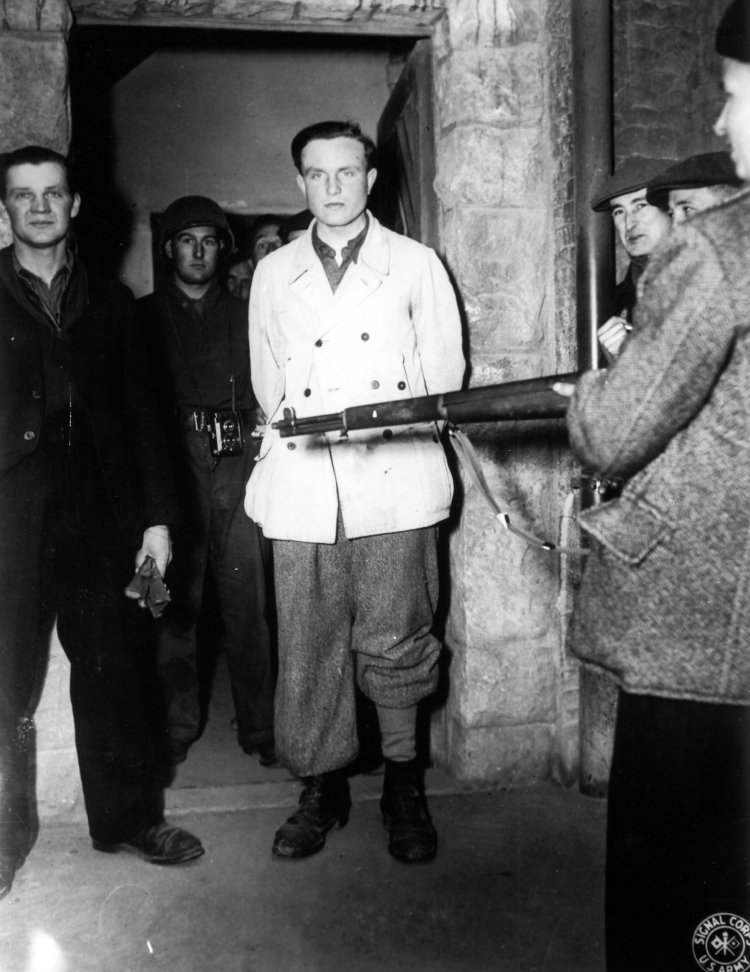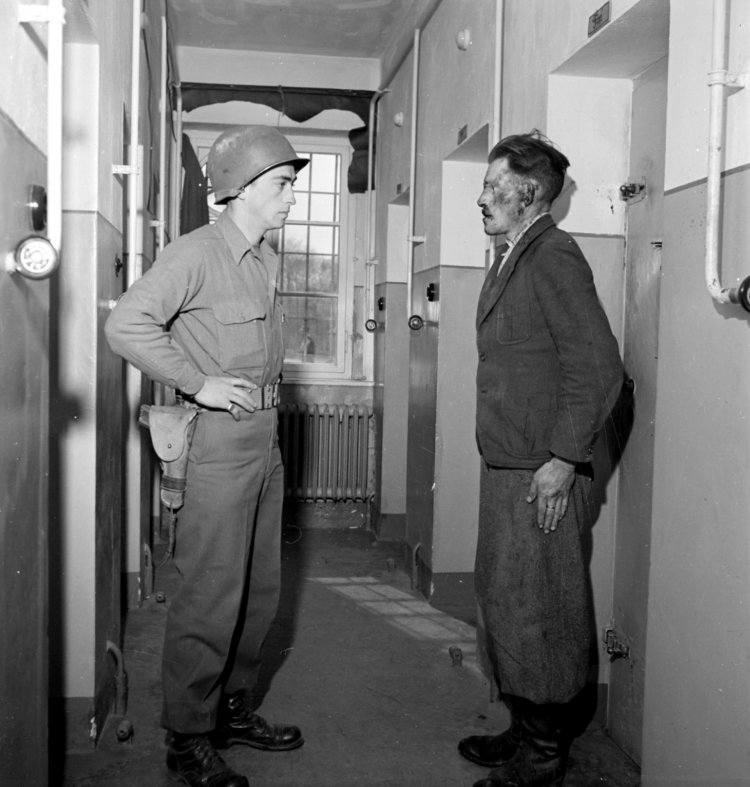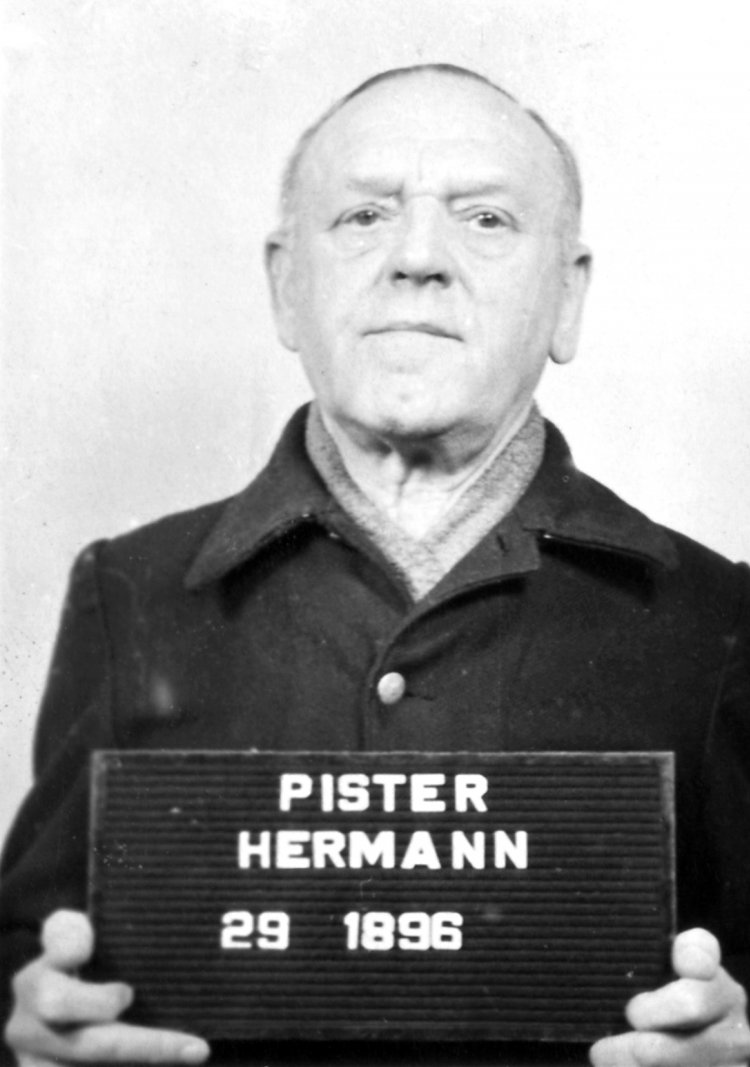
The Perpetrators
Das war Buchenwald. Ein Tatsachenbericht
SS Men as Prisoners
The majority of the Buchenwald SS absconded as the U.S. Army approached the camp on the early afternoon of 11 April 1945. Only a few remained behind. On the same day, armed former inmates organized patrol rounds during which they succeeded in capturing 76 SS men.
The voice of an SS man rang out from the camp loudspeakers for the last time around noon on 11 April 1945. Report Commander Hofschulte issued the order: “All members of the SS leave the camp immediately!” Almost the entire SS complied. Only a handful of members of the guard force, most of them low-ranking Ukrainian SS men, remained in the vicinity of the camp.
In the hours that followed, armed inmate combat patrols combed the surrounding forests and villages and captured a number of SS men, some in uniform and some in inmates’ suits they had taken from the depot. They were taken to the camp detention cell building, among other places. Some of the SS men were beaten so severely by the enraged inmates that they died as a result. Most of the prisoners were transferred to American prisoner-of-war camps.
When the first U.S. Army photographers arrived at the camp on 14 April, they directed their attention towards the inmates – the survivors as well as the dead. Hardly any notice was taken of the imprisoned SS men. Only one photo shows an SS man who has just been captured by inmates. It is presumably Hermann Hofschulte, who had tried to escape in civilian clothes.
Lee Miller was the only photographer to take pictures of the SS men imprisoned in the detention cell building. She held them in disdain, described them as despicable and cringing, and endeavoured to document them as such in her photographs. A number of her pictures appeared in Vogue magazine.

Victory edition of the American magazine Vogue, June 1945
Buchenwald Memorial Collection

U.S. Signal Corps, after 11 April 1945
National Archives at College Park, Maryland

Lee Miller, war correspondent, after 20 April 1945
© Lee Miller Archives, England 2021. All rights reserved. leemiller.co.uk

Lee Miller, war correspondent, after 20 April 1945
© Lee Miller Archives, England 2021. All rights reserved. leemiller.co.uk

U.S. Signal Corps, after 11 April 1945
Service Historique de la Défense, Vincennes

Robert H. Wescott,
Robert H. Wescott, U.S. Signal Corps, 8 June 1945
National Archives at College Park, Maryland

Harold M. Roberts,
Harold M. Roberts, U.S. Signal Corps, 14 April 1945
National Archives at College Park, Maryland
Defendants in the Dachau Buchenwald Trial
On 11 April 1947, two years after the liberation of the camp, the Buchenwald Trial began in Dachau, primarily against members of the former command staff. Military photographers of the Signal Corps documented the proceedings.
Officers of the U.S. Army investigation authority had already begun showing photographs to former inmates shortly after the camp’s liberation. The latter were to identify their tormentors in pictures found in the SS garrison. By early 1947, altogether 793 persons bearing a connection to the crimes committed at the Buchenwald concentration camp and its subcamps were being held by the Allies, primarily members of the SS but also civilians and inmate kapos. Of these persons, ultimately 31 of the most heavily incriminated perpetrators were selected for trial. Their indictments were drawn up and their photos taken: one frontal and one profile view in each case.
The trial was held before a military tribunal on the grounds of the former Dachau concentration camp. Among the defendants were the camp commander Hermann Pister and Ilse Koch, the wife of the first camp commander. The army photographers Dean L. Dennis and John Chambers accompanied the trial. In a pictorial documentation comprising 120 photographs, they recorded the hearings of both the witnesses and the defendants. As is clearly reflected in the photographs, there was a great amount of tension among all involved, an indication of the explosiveness of the crimes being tried.
The trial ended on 14 August 1947 with a pronouncement of judgement: Twenty-two defendants were sentenced to death, five to life imprisonment, four received prison terms of between ten and twenty years. Petitions for clemency were submitted from all sectors of the German population. The SS perpetrator one had known as a neighbour or father appeared much more credible than the testimony of survivors. By 1951, nine of the death sentences had been executed. All other convicted persons were granted amnesty by the mid-1950s.



Photographer unknown, May 1942
Landesarchiv Thüringen – Hauptstaatsarchiv Weimar

U.S. Signal Corps, April 1947
National Archives at College Park, Maryland

U.S. Signal Corps, April 1947
National Archives at College Park, Maryland

U.S. Signal Corps, April 1947
National Archives at College Park, Maryland

U.S. Signal Corps, April 1947
National Archives at College Park, Maryland

U.S. Signal Corps, April 1947
National Archives at College Park, Maryland

U.S. Signal Corps, April 1947
National Archives at College Park, Maryland

U.S. Signal Corps, April 1947
National Archives at College Park, Maryland

U.S. Signal Corps, April 1947
National Archives at College Park, Maryland

John Chambers,
John Chambers, U.S. Signal Corps, 16 April 1947
National Archives at College Park, Maryland

Dean L. Dennis,
Dean L. Dennis, U.S. Signal Corps, 8 July 1947
National Archives at College Park, Maryland

Dean L. Dennis,
Dean L. Dennis, U.S. Signal Corps, 8 July 1947
National Archives at College Park, Maryland

Dean L. Dennis,
Dean L. Dennis, U.S. Signal Corps, 14 August 1947
National Archives at College Park, Maryland

